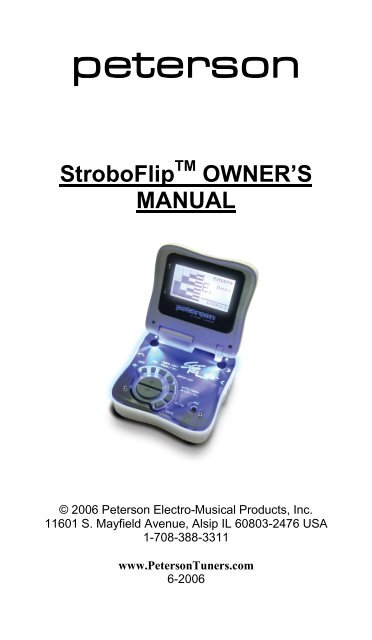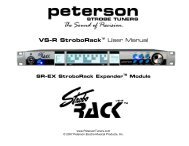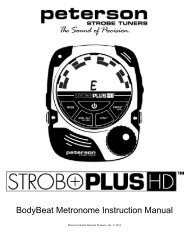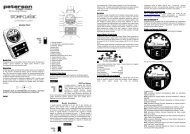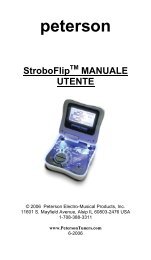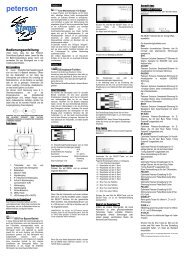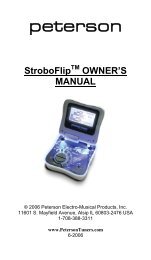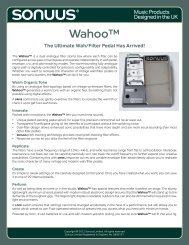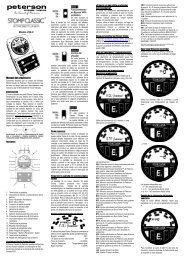Stroboflip Manual - Peterson Tuners
Stroboflip Manual - Peterson Tuners
Stroboflip Manual - Peterson Tuners
You also want an ePaper? Increase the reach of your titles
YUMPU automatically turns print PDFs into web optimized ePapers that Google loves.
peterson<br />
StroboFlip TM OWNER’S<br />
MANUAL<br />
© 2006 <strong>Peterson</strong> Electro-Musical Products, Inc.<br />
11601 S. Mayfield Avenue, Alsip IL 60803-2476 USA<br />
1-708-388-3311<br />
www.<strong>Peterson</strong><strong>Tuners</strong>.com<br />
6-2006
peterson<br />
VS-F STROBOFLIP<br />
Contents Page<br />
Getting Started 4<br />
Power 5<br />
Brief Description of Features 5<br />
TP Pickup Tuning 6<br />
Pitch Holder 7<br />
Changing the Settings 8<br />
Concert A reference 9<br />
Drop Tune/Transpose 10<br />
Temperaments 11<br />
Sweeteners 12<br />
Key Control 13<br />
Drop-Tuning Control 14<br />
Temperament Root Control 15<br />
Temperament Base Note 16<br />
Cent/Hz Control 17<br />
Auto/<strong>Manual</strong> Note Detection Control 19<br />
Auto-Power-Off 20<br />
A Word about Temperaments 21<br />
A Word about Sweeteners 23<br />
Setting Guitar & Bass Intonation 27<br />
Tuning Guitars 28<br />
Tuning Pedal Steel Guitars 29<br />
Tuning Lap Steel Guitars 29<br />
Tuning Dobro ® or Resonator Guitars 29<br />
Tuning Violin, Viola or Cello 30<br />
Tuning Early Music Instruments 30<br />
Tuning Brass & Woodwind Instruments 30<br />
Tuning Bagpipes 30<br />
Tuning Acoustic Instruments in General 31<br />
Tuning to Another Instrument 31<br />
Programming Your Own Temperaments 31<br />
Concert A Audio Reference Signal 35<br />
Tips to Keep Your Instrument in Tune & Offsets 35<br />
Just Intonation Tables & FAQ 36<br />
Warranty 39<br />
Technical Specifications 39<br />
3
4<br />
peterson<br />
VS-F StroboFlip Instruction <strong>Manual</strong><br />
Congratulations on your purchase of the <strong>Peterson</strong><br />
StroboFlip! As the latest product utilizing peterson’s<br />
visionary Virtual Strobe Technology, the concept<br />
behind this tuner is a true marriage of peterson’s<br />
unsurpassed Rotating Strobe-Disc Tuning Technology<br />
with the latest advances in analog, digital, and display<br />
technologies available today.<br />
5VDC<br />
IN<br />
Getting Started<br />
Protective<br />
Flip-Top Screen<br />
Enclosure<br />
Reference<br />
Tone Out<br />
Increment<br />
Control<br />
Built-In<br />
Mic<br />
Signal<br />
IN<br />
Strobe<br />
Screen<br />
Menu<br />
Buttons<br />
Signal<br />
Thru
VS-F StroboFlip TM<br />
Power<br />
Your new StroboFlip TM is powered by 3 AA batteries. To<br />
change or access the batteries, press and carefully<br />
remove the battery access door on the underside of the<br />
tuner.<br />
The StroboFlip 5V Adapter (item # 171500) allows you to<br />
power the StroboFlip from an AC source.<br />
It is designed to work with any voltage standard such as<br />
100V, 120V, 220V or 240V without adjustment. Owners<br />
who are residents of the UK, Republic of Ireland,<br />
Australia, New Zealand, Israel & Africa may need to<br />
acquire a plug adapter. The correct DC polarity is as<br />
follows:<br />
A Brief Description of the Features<br />
The <strong>Peterson</strong> StroboFlip is a compact hand-held tuner<br />
with an accuracy of 1/10 th of one cent (1/1000 th of one<br />
semitone or half step). It is also a programmable tuner,<br />
allowing you to program up to eight of your own<br />
tempered tunings as well as giving you access to 33<br />
other preset temperaments and Sweeteners TM .<br />
StroboFlip – Basic Use:<br />
You can use your StroboFlip right out of the box.<br />
Just lift the screen to a viewable angle, press the ON<br />
button and- using the built-in mic or plugging your<br />
instrument into the “INPUT” jack - play a note.<br />
The resulting strobe image flows upwards to indicate<br />
that the note is sharp and downwards to indicate that the<br />
note is flat. The note is in tune when the image is<br />
immobile.<br />
A “” sign to the left of the Virtual Strobe TM image<br />
means you’re “way too sharp” and a “” sign means<br />
you’re “way too flat”.<br />
5
If you wish to try out some of the StroboFlip’s exclusive<br />
tuning presets, press the TMPR/SWT button & use the<br />
arrow buttons to select the various presets. For a<br />
description of these settings, see Page 14.<br />
TP Tuning Pickup<br />
Use the clip-on tuning pickup to improve signal transfer<br />
from instrument to tuner in noisy environments.<br />
Simply attach the pickup to the instrument by clipping it<br />
onto the bridge, headstock, bell or lead pipe of the<br />
instrument to be tuned.<br />
6
Pitch Holder TM<br />
Use the mounting clamp to attach the tuner to a mic<br />
stand, music stand, rack case or workspace shelf to<br />
keep the tuner safely within easy reach.<br />
Attach the Pitch Holder TM to the StroboFlip TM by inserting<br />
the screw into the camera-style socket in the base of the<br />
StroboFlip and tighten.<br />
7
Changing the settings on your StroboFlip<br />
Below the Strobe screen, in the body of the tuner, there<br />
are power off & on buttons and five “Menu” buttons.<br />
By pressing each button in turn, you can see the various<br />
options offered by the StroboFlip TM .<br />
The screens are as follows:<br />
Temperament/Sweetener TM - Choice of 42 (default is Equal<br />
Temperament)<br />
Root - Choice of 12 (default is C). Available only if a<br />
temperament is chosen<br />
Drop-Tune + Capo/Key Transpose – Choice of 12 (Factory<br />
default is 0 or C)<br />
Cent Control – Range of +/- 50 cents in 0.1-cent increments<br />
Concert A Reference – 390Hz to 490Hz (Factory default is<br />
A=440)<br />
Auto/<strong>Manual</strong> Note Detection (Factory default is Auto)<br />
Auto Power Off- 2 to 35 minutes or Disable (default is<br />
Disable)<br />
Temperament Base – A or C (default is A)<br />
Save - Press the save button to save a particular parameter.<br />
8
Two larger “Value” buttons marked with signs are<br />
located next to the Menu buttons<br />
To change a setting or a parameter of a preset on the<br />
tuner, press the relevant Menu button and use the <br />
“Value” buttons to change that particular parameter.<br />
Concert A Reference Range: 390Hz to 490Hz<br />
adjustable in 0.5Hz increments. Press the “Hz” button<br />
and use the t buttons to adjust the Hertz value. To save<br />
the setting as your default, press the Save button.<br />
9
Drop-Tune/Transpose – Unlimited<br />
Drop/Transpose any Sweetener TM to any key. Press the<br />
“DROP/KEY” button and use the buttons to adjust the<br />
Note Name/Drop Tune value. To save the setting as<br />
your default, press the Save button.<br />
10
Temperaments<br />
There are 16 temperaments (including 4 which are userprogrammable)<br />
in your StroboFlip.<br />
TEMPERAMENTS (All 12 notes are altered in pitch)<br />
PRESET TYPE PRESET TYPE<br />
EQU Equal KLN Kellner<br />
JMA Just Major YNG Young<br />
JMI Just Minor VAL Vallotti<br />
4MT Meantone ¼ RAM Rameau<br />
6MT Meantone1/6 T-1 User Programmable Temperament<br />
PYT Pythagorean T-2 User Programmable Temperament<br />
WRK Werckmeister III T-3 User Programmable Temperament<br />
KRN Kirnberger III T-4 User Programmable Temperament<br />
Press the TMPR/SWT button and use the buttons to<br />
choose the desired temperament and press the ¢/Hz<br />
button to exit the menu thereby activating the chosen<br />
Temperament.<br />
11
Sweeteners TM<br />
There are 18 Sweeteners and 7 Buzz Feiten Tuning<br />
System® settings in your StroboFlip, including 4 which<br />
are user-programmable.<br />
SWEETENERS (Some or all notes are altered in pitch)<br />
PRESET TYPE PRESET TYPE<br />
EQU Equal Temperament BF12 Buzz Feiten 12 String Octave<br />
GTR Sweetened Guitar SE9 E9 Steel Guitar (Sharp E’s)<br />
ACU Sweetened Acoustic SC6 C6 Steel Guitar<br />
DADGAD Sweetened DADGAD OE9 E9 Steel Guitar (E’s 00.0 cent)<br />
G12 12 String Standard DBO Perfect Thirds for Dobro<br />
G12 12 String Octave DB Half Tempered Thirds for Dobro<br />
BAS Sweetened Bass VLN Perfect 5ths for Violin<br />
BFE Buzz Feiten Electric VLA Perfect 5ths for Viola<br />
BF IN BFTS Electric Intonatipn CLO Perfect 5ths for Cello<br />
BFB Buzz Feiten Bass T-1 User Programmable Sweetener<br />
BFB IN BFTS Bass Intonation T-2 User Programmable Sweetener<br />
BFA Buzz Feiten Acoustic T-3 User Programmable Sweetener<br />
BF12 Buzz Feiten 12 String Std. T-4 User Programmable Sweetener<br />
Press the TMPR/SWT button again to access the<br />
Sweeteners, again using the buttons to select one<br />
and press the ¢/Hz button to exit the menu thereby<br />
activating the chosen Sweetener.<br />
The tuner will remember whether you used the<br />
temperament or Sweetener TM menu last and will default<br />
to that menu automatically.<br />
12<br />
◑
Key Control<br />
This control is used to help players of non-C instruments<br />
such as saxophone (Bb), French horn (F) and trumpet<br />
(Eb) to transpose notes when reading from C notation.<br />
Press the Drop/Key button and use the to select the<br />
required key.<br />
13
To save this as your default, press the SAVE button.<br />
Drop Tuning Control<br />
For guitarists who wish to lower or raise their tuning<br />
without having to learn the new note names, the<br />
DROP/KEY control enables the renaming of the new<br />
pitches to be the same as the present ones.<br />
Press the DROP/KEY button and use the buttons to<br />
select the required drop tuning degree; ♭1 means one<br />
half-step down, ♭2 means one step down etc. CAPO +1<br />
means capo at the first fret, CAPO +2 means capo at the<br />
second fret etc.<br />
14
This is an intelligent control, which also recalculates the<br />
interval offsets to be correct for the new tuning*.<br />
* The StroboFlip needs to be in Sweetener mode for this to work.<br />
Temperament Root Control<br />
This control is used to determine which note should be<br />
the tonic or “starting note” in a temperament. The default<br />
root of all temperaments is C, but this can be changed to<br />
any one of 11 other root notes.<br />
When in the Temperament menu, press the DROP/KEY<br />
control twice (once for KEY, twice for ROOT)*<br />
* The StroboFlip needs to be in Temperament mode for this to work.<br />
15
ROOT is available as a separate control for the<br />
Temperament section only. When transposing a<br />
Sweetener, use the DROP/KEY button. This causes the<br />
Root to combine with the Key control enabling users to<br />
transpose any Sweetener TM while retaining the correct<br />
offsets using just one control.<br />
Temperament Base Note<br />
For temperaments, the StroboFlip TM offers a choice<br />
between Concert A or Root reference points. When<br />
Concert A is active, the tuner’s reference point will be A4<br />
at 440Hz or whatever Hz value you select (A440Hz is<br />
the default value).<br />
When Root is selected, the tuner’s reference point is<br />
whatever temperament root is active at any given time.<br />
To select the base note, press and hold the SETUP<br />
button while you switch the tuner on.<br />
Press the SETUP button once more to access the<br />
TMPR-BASE screen.<br />
16
Use the buttons to toggle between the two choices.<br />
Historic temperaments which are used in C should have<br />
an A base - but if you are a horn player practicing chord<br />
construction and harmony, choosing C base and Just<br />
Major or Minor will allow you to have root notes which<br />
are closer to fixed pitch instruments like piano, guitar etc.<br />
while allowing consonant intervals within the<br />
temperament itself.<br />
Press the SAVE button to save the chosen value to<br />
memory.<br />
*Only temperaments, not Sweeteners, are affected by this control.<br />
Cent/ Hz Control<br />
Cents - Adjustable from + (plus) to – (minus) 50 cents<br />
in 0.1 cent increments.<br />
Press the ¢/Hz button and use the buttons to adjust<br />
the cent value.<br />
17
Hertz – This control is used to calibrate the tuner to a<br />
desired common standard pitch. The StroboFlip is<br />
adjustable in 0.5Hz increments from 390Hz to 490Hz.<br />
18
Press the ¢/Hz button again to access and use the <br />
buttons to adjust the Hz value. To save a Hertz value as<br />
a default value, press the Save button.<br />
Auto/ <strong>Manual</strong> Note Detection Control<br />
The StroboFlip TM can be set to detect and name<br />
incoming signals or allow the user to set a target note.<br />
Press the Auto/ Man button and use buttons to select<br />
required mode.<br />
Auto-Power-Off<br />
Press and hold the SETUP button and switch the<br />
StroboFlip on.<br />
19
The Auto-Power-Off screen appears.<br />
Using the buttons, set the StroboFlip’s Auto-Power<br />
Off timer to an operating time period between 2 and 35<br />
minutes after which the tuner will shut down<br />
automatically, and press the SAVE button.<br />
To disable this control, press the button until the<br />
indicator level reaches “DISABLE” and press the SAVE<br />
button.<br />
The Tuner will now operate until it is manually switched<br />
off. The StroboFlip’s factory default is “DISABLE”.<br />
20
A Word about Temperaments<br />
Musical temperaments are systems used to determine<br />
where each note in the octave (12 notes) is to be placed<br />
in relation to the others.<br />
The most commonly used temperament in modern<br />
music is the Equal Temperament, in which the “space”<br />
or interval between each note and its immediate<br />
neighbor is always 100.0 cents.<br />
However, there are many other methods used to divide<br />
the octave. These temperaments are called Unequal.<br />
Press the Temp button and use the buttons to scroll<br />
through the different temperaments:<br />
Equal: All intervals are exactly 100 cents wide.<br />
Just Major (JMA): Just intonation is possibly the oldest<br />
known way of dividing the octave. The Just Major<br />
version features beatless major thirds, used to tune<br />
brass & woodwind ensembles.<br />
Just Intonation is often called “Natural” tuning, because<br />
of its consonant intervals. It is usually used by brass<br />
players to enhance the sound of ensemble playing;<br />
elements of this are also used in choral intonation.<br />
Just Minor (JMI): Beatless minor thirds, see above.<br />
¼ Comma Meantone* (4MT): Meantone temperament,<br />
used for harpsichord.<br />
1/6 Comma Meantone* (6MT): Meantone temperament<br />
used for early music instruments such as lute, viol, viola<br />
da gamba etc.<br />
21
Pythagorean (PYT): Beatless fifths, introduced by<br />
Greek mathematician Pythagoras (569 – 475 BC)<br />
Werckmeister III* (WRK): Introduced by German<br />
organist Andreas Werckmeister (1645 - 1706), for tuning<br />
organ and harpsichord. Flexible tuning by which some<br />
distant keys are playable. Each key retains a particular<br />
color.<br />
Kirnberger III* (KRN): Composer, theoretician and<br />
student of Bach, Johann Philipp Kirnberger (1721-1783)<br />
conceived the Kirnberger temperament. It is often<br />
referred to as the simplest of temperaments, having no<br />
pure thirds except the C-E interval, thus lending itself to<br />
music written in C Major. Avoid pieces in B, F# or Db<br />
which were rare at the time of inception. For tuning<br />
organ and harpsichord.<br />
Kellner (KLN): The original “wohltemperirte Clavier”<br />
(well tempered) tuning introduced by Bach in the early<br />
1700s and rediscovered by Professor Herbert Anton<br />
Kellner in the 1970s. The well-tempered fifths are almost<br />
all equal, being reduced by 1/5 of a Pythagorean comma<br />
(4.7 cents).<br />
Young* (YNG): Thomas Young (1773 – 1829)<br />
introduced the original RGB theory of color. Following<br />
that, he applied similar thought to musical temperament.<br />
C & F are stable and there are some particularly smooth<br />
sounding 3rds, 4ths and 5 th scattered among the keys.<br />
Used widely in forte piano tuning and harpsichord.<br />
Vallotti* (VAL): Francesco Antonio Vallotti’s (1697-<br />
1780) well temperament for harpsichord is very close to<br />
Equal temperament. It is one of the mildest of the classic<br />
well temperaments.<br />
22
Rameau* (RAM): This late French Baroque<br />
temperament by Jean-Philippe Rameau (1683 - 1764) is<br />
also known as “Temperament Ordinaire” and contains<br />
three beatless major thirds.<br />
T-1: User Programmable Temperament<br />
T-2: User Programmable Temperament<br />
T-3: User Programmable Temperament<br />
T-4: User Programmable Temperament<br />
*Temperaments marked with an asterisk are often tuned using a<br />
Concert A setting of A=415Hz or A=392Hz depending on the period<br />
the music to be played was written in.<br />
A word about Sweeteners TM<br />
“Sweetener” is a more contemporary take on the term<br />
temperament and is used to describe a group of twelve<br />
or fewer notes which are precisely and individually<br />
adjusted in degrees of sharpness and flatness to<br />
sweeten the tuning of instruments using a <strong>Peterson</strong><br />
tuner.<br />
To access the Sweetener menu, press the TMPR/SWT<br />
button again.<br />
23
Use the buttons to scroll through the different<br />
temperaments<br />
Guitar (GTR TM) <strong>Peterson</strong> guitar-specific Sweetener,<br />
which makes 4 th & 5 th intervals (as well as the G to B<br />
third) more consonant.<br />
Acoustic (ACU TM ) <strong>Peterson</strong> acoustic guitar-specific<br />
Sweetener in the form of a unique stretch tuning.<br />
DADGAD (DAD TM ) <strong>Peterson</strong> Sweetened Tuning for<br />
guitars tuned to DADGAD<br />
G12 (G12 STD TM ) <strong>Peterson</strong> Sweetened Tuning for the<br />
6 standard strings of 12-string guitars.<br />
G12 (G12 OCT TM ) <strong>Peterson</strong> Sweetened Tuning for the 6<br />
octave strings of 12-string guitars.<br />
Bass (BAS TM ) <strong>Peterson</strong> bass guitar-specific Sweetener<br />
for use when playing with piano.<br />
24
B F -Elec (B F E): Tempered tuning for electric guitars<br />
featuring the Buzz Feiten Tuning System ® *<br />
B F -Elec IN (B F E IN ): Intonation offsets for electric guitars<br />
featuring the Buzz Feiten Tuning System ®<br />
B F -Bass (B F B): Tempered tuning for bass guitars<br />
featuring the Buzz Feiten Tuning System ®<br />
B F- Bass IN (B F B IN ): Intonation offsets for bass guitars<br />
featuring the Buzz Feiten Tuning System ®<br />
B F -Acoustic (B F A): Tempered tuning for acoustic<br />
guitars featuring the Buzz Feiten Tuning System ®<br />
B F -12STD (B F 12) Tempered tuning for the 6 standard<br />
strings of 12-string guitars featuring the Buzz Feiten<br />
Tuning System ®<br />
B F -12OCT (B F -12): Tempered tuning for the 6 octave<br />
strings of 12-string guitars featuring the Buzz Feiten<br />
Tuning System ®<br />
PSG-SE9 (SE9): Sweetened tuning derived from the Jeff<br />
Newman system for pedal & lap steel guitar tuned to E9.<br />
The open E’s are 9.8 cents sharp.<br />
25
PSG-SC6 (SC6): Sweetened tuning derived from the<br />
Jeff Newman system for pedal steel guitar tuned to C6.<br />
PSG-OE9 (OE9): Sweetened tuning derived from the<br />
Jeff Newman system for pedal steel guitar tuned to E9.<br />
The open E’s are tuned straight up at 0.0 cents.<br />
DOBR○ ® **- (DB○) Sweetened Dobro Tuning (Pure<br />
3rds for Open A, D or G tunings) - Please note: Tuning<br />
should be done in playing position.<br />
DOBR◑ ® - (DB◑) Sweetened Dobro Tuning (Half<br />
Tempered 3rds for Open A, D or G tunings) - Please<br />
note: Tuning should be done in playing position.<br />
VIOLIN (VLN) (C)GDAE in perfect 5 th intervals for<br />
violin tuning (4 & 5 string violins) Please note: Tuning<br />
should be done by bowing, not by plucking the strings.<br />
VIOLA (VLA) CGDA in perfect 5 th intervals for viola<br />
tuning. Please note: Tuning should be done with a bow.<br />
CELLO (CLO) CDGA perfect 5 th intervals for cello<br />
tuning. Please note: Tuning should be done with a bow.<br />
S-1: User Programmable Sweetener<br />
S-2: User Programmable Sweetener<br />
S-3: User Programmable Sweetener<br />
S-4: User Programmable Sweetener<br />
*Buzz Feiten Tuning System is a registered trademark of Buzz Feiten Design and has no<br />
affiliation with <strong>Peterson</strong> Electro-Musical Products, Inc.<br />
** Dobro is a registered trademark of the Gibson Guitar Corp. and has no affiliation with<br />
<strong>Peterson</strong> Electro-Musical Products, Inc.<br />
26
Temperament Root - This is the note at which the<br />
temperament starts (the tonic note of the tempered<br />
scale). The default root is C, but it can be altered to any<br />
one of 12 roots. The temperament is then automatically<br />
altered to reflect the new scale degree notes.<br />
Temperament Base - This is the note by which the<br />
temperament takes its “Concert Pitch” reference. This<br />
can be C or A (default). The classical temperaments like<br />
Werckmeister III etc. are usually used with an A base.<br />
Sweeteners TM are not affected by the Temperament<br />
Base.<br />
Setting guitar & bass intonation using your<br />
StroboFlip<br />
After deciding on string gauge, setting string height (nut & bridge),<br />
neck relief, and all other factors that affect the guitars intonation<br />
considerably, the individual string lengths need to be adjusted. For<br />
this task, use Equal temperament in the StroboFlip’s TMPR menu.<br />
Lower the pickups away from the strings to avoid<br />
"doubling" and electromagnetic pull.<br />
Lay the guitar flat on a bench to adjust it, but always check<br />
the intonation with the instrument in the playing position, as<br />
the readings will be visibly (and later audibly) different. You<br />
should always aim to freeze or "cage" the image on the<br />
Strobe Tuner display; the less movement the more<br />
accurate the results.<br />
A common technique in setting the intonation is the 12th fret &<br />
flageolet comparison method. In this method, the flageolet or<br />
"harmonic" of the 12th fret is compared to the fretted string at the<br />
12th fret, and saddle position is adjusted as follows:<br />
If the fretted note is flat compared to the flageolet note,<br />
move the bridge saddle forward to shorten the string.<br />
If the fretted note is sharp compared to the flageolet note,<br />
move the bridge saddle back to lengthen the string.<br />
Adjust until both fretted note and flageolet are identical in<br />
pitch.<br />
While this is a common system, it is not always the most satisfactory.<br />
27
One popular alternative is to adjust each string so that it is in tune at<br />
two points an octave apart from each other on the fret board using a<br />
strobe tuner. Using the 5th and 17th fret as an example:<br />
28<br />
Tune a string at the 5th fret.<br />
Check the string at the 17th. If sharp, move the saddle<br />
back, thus lengthening the string. If flat, shorten the string<br />
by moving the saddle forward. Remember to fret the string<br />
using the pressure that you would normally apply while<br />
playing.<br />
Keep repeating this process until each string is in tune as<br />
much as possible at both the 5th and 17th frets.<br />
This method takes time, and has to be repeated if you change string<br />
gauges, but if properly executed, it yields very satisfactory results.<br />
Now, depending on your own taste, tune your guitar using one of the<br />
StroboFlip’s many Sweeteners TM . Find out how your instrument can<br />
really sound!<br />
The methods described above are within anybody's reach.<br />
All you need are your ears and your peterson strobe<br />
tuner!<br />
Please note that we have not referred to any method involving<br />
structural changes to the instrument. These are best discussed with a<br />
professional instrument technician.<br />
Tuning Guitars<br />
<strong>Peterson</strong> tuners are the most sensitive and accurate<br />
tuners in the world. They differ completely from digital/<br />
needle tuners, so you need to interact differently with<br />
them.<br />
Brush the string lightly with the flesh of your thumb; the<br />
StroboFlip TM requires very little signal to perform<br />
optimally. Pluck the string once, not repeatedly.<br />
The StroboFlip’s superior sensitivity means that the<br />
image of the string’s signal appears IMMEDIATELY<br />
(without the time-lag common in digital tuners) and<br />
remains on the display longer. Always tune in the playing<br />
position, even when setting intonation.<br />
If you’re a 12 string guitar player, you can choose to use<br />
EQU to tune all 12 strings or assign a separate<br />
sweetener to both the standard and octave strings.
To use a StroboFlip Sweetener for Baritone guitars,<br />
select a drop-tune setting of +7 followed by the<br />
Sweetener of your choice.<br />
Tuning Pedal Steel Guitars<br />
<strong>Peterson</strong> tuners are the first and only tuners to contain<br />
specific tempered tunings for pedal steel similar to the<br />
settings popularized by Jeff Newman.<br />
Generally speaking, these tunings should be executed<br />
with both A & B pedals depressed unless the guitar has<br />
minimal cabinet drop.<br />
These presets are chromatic and are designed to cover<br />
both open strings, pedals and levers.<br />
SE9 is a non-Equal temperament in which the E notes<br />
are 9.8 cents sharp<br />
0E9 is a non-Equal temperament in which the E notes<br />
are at 00.0 cents<br />
SC6 is a non Equal temperament for steel guitars using<br />
the C6th tuning.<br />
Tuning Lap Steel Guitars<br />
Many specially tempered lap steel tunings are available<br />
on our forum & website www.petersontuners.com .<br />
Tuning Dobro ® * or Resonator Guitars<br />
The StroboFlip contains the first and only presets with<br />
pure and half tempered third tunings for resonator<br />
guitars. The following tunings are possible using either of<br />
the two presets:<br />
Open A (A-C#-E-A-C#-E )<br />
Open D (D-A-D-F#-A-D)<br />
Open G (G-B-D-G-B-D)<br />
Remember to tune with your instrument in the playing<br />
position.<br />
* Dobro® is a registered trademark of the Gibson Guitar Corporation.<br />
Tuning Violin, Viola or Cello<br />
The StroboFlip TM contains the first and only preset pure<br />
fifths for violin, viola and cello. Tune using the bow, as<br />
plucking the strings does not allow for string deflection<br />
due to the weight of the bow.<br />
For quick tuning in adverse conditions, plug the TP<br />
pickup into the StroboFlip and attach the pickup to the<br />
instrument to be tuned.<br />
29
Tuning “Early Music” instruments<br />
The StroboFlip’s long list of classical temperaments can<br />
be put to good use for instruments such as harpsichord,<br />
lute, and viola da gamba. Remember to change the<br />
concert pitch to suit the relevant instrument or period of<br />
music. Common Early Music concert pitch is A=415Hz,<br />
but 392Hz and 430Hz are also widely used. The<br />
StroboFlip’s concert pitch reference is adjustable in<br />
0.5Hz increments from 390Hz all the way to 490Hz. The<br />
Meantones (1/4 & 1/6) are widely used for these<br />
instruments.<br />
Tuning Brass & Woodwind Instruments<br />
Use the StroboFlip’s built-in microphone to pick up the<br />
instrument’s sound. In noisy environments, attach the TP<br />
tuning pickup to your instrument’s lead pipe or bell and<br />
plug the other end into the tuner. Try a few locations on<br />
the instrument to get the best results.<br />
Tuning Bagpipes<br />
For Great Highland Bagpipes, set the base note & root<br />
to A, change the Concert A reference to 476Hz (or<br />
whatever the Pipe Major’s standard is) and select the<br />
Just Major preset (JMA). Attach the <strong>Peterson</strong> TP pickup<br />
to the drones and then to the chanter to tune.<br />
For Uilleann, Border, Welsh & Biniou Pipes, set the base<br />
note to A, the root to D, change the Concert A reference<br />
to 440Hz and select the Just Major preset. Attach the TP<br />
tuning pickup first to the drones and then to the chanter<br />
to tune.<br />
Tuning acoustic instruments in general<br />
Unamplified acoustic instruments can be tuned using the<br />
StroboFlip’s built-in mic or alternately the <strong>Peterson</strong> TP<br />
clip-on tuning pickup which senses the instrument’s<br />
signal.<br />
An external microphone with a ¼” plug can also be used.<br />
30
Instruments tuned to an unknown or fixed<br />
Concert A setting.<br />
Play a note on the instrument that is central relative to<br />
the complete range of notes playable. While the note is<br />
sounding, press the Hertz button and adjust the<br />
StroboFlip’s Concert A value until the Strobe image<br />
stops moving.<br />
The StroboFlip is now correctly calibrated to the<br />
instrument in question and can be used to tune other<br />
instruments so that they are also in tune with this<br />
instrument.<br />
Programming your own temperaments<br />
The StroboFlip TM offers the ability to program four<br />
custom user-designed temperaments.<br />
Put the StroboFlip into Program mode by pressing and<br />
holding down the PROG button while you switch the<br />
tuner on.<br />
Using the buttons, choose either T-1, T-2, T-3 or T-<br />
4 programmable temperaments if you need separate<br />
control over root and key parameters. Choose S-1, S-2,<br />
S-3 or S-4 to have the root and key combined resulting<br />
in a simpler “drop or capo tune” function.<br />
31
Press the PROG button once more to begin.<br />
The note C will be the first note to be shown, use the <br />
buttons to enter the desired offset value (if any) for the<br />
note C.<br />
32
To advance to the next note, press the PROG button<br />
again and enter the cent value for this note as above.<br />
Repeat until all offsets are entered.<br />
To save the settings, press the Save button.<br />
Press the SAVE button once more to confirm, or press<br />
PROG to return to programming.<br />
33
Press the SAVE button once more to save the offsets<br />
you entered to memory<br />
Audio Reference Signal<br />
Audio reference signals (C4 to B4) are available from the<br />
Audio Out jack socket on the left hand side of the<br />
StroboFlip TM . Plugging a cord with a 1/8 th inch (3.5mm)<br />
jack into the socket activates the tone, which can then<br />
be plugged into any amplifier via the other end of the<br />
cord. Set the Auto/Man control to MAN and scroll up to<br />
A4 using the arrow buttons. Always set the amplifier’s<br />
volume to zero before plugging in. This signal can also<br />
be used to calibrate a software tuner like <strong>Peterson</strong><br />
StroboSoft TM , thus eliminating computer sound card<br />
errors.<br />
NOTE: Others may use your tuner, please make sure they know when it<br />
is not in default mode, to avoid detuning on a standard instrument.<br />
34
Tips to keep your instrument in tune<br />
1 Wash your hands before playing<br />
2 Allow the instrument to reach room temperature before tuning<br />
3 Always tune up to the target pitch, never down<br />
4 Keep the instrument at a constant temperature while playing<br />
5 Check your tuning frequently<br />
6 Wipe down your instrument with a cloth after playing<br />
7 Change strings as frequently as your budget allows<br />
8 If changing string type/gauge, re-intonate/regulate the instrument<br />
9 On fretted instruments, check for fret wear<br />
10 Clean your instrument regularly and thoroughly<br />
11 On stringed instruments, keep bearing edges lubricated<br />
12 On wind instruments, keep keys/valves lubricated, check pads.<br />
PETERSON STROBOFLIP OFFSETS<br />
TMPR/SWT PRESET C C# D D# E F F# G G# A A# B E▲<br />
EQUAL EQU 0.0 0.0 0.0 0.0 0.0 0.0 0.0 0.0 0.0 0.0 0.0 0.0 0.0<br />
DADGAD DAD 0.0 0.0 -0.6 0.0 0.0 0.0 0.0 -1.2 0.0 1.1 0.0 0.0 0.0<br />
PSG-SE9 SE9 -17.8 -5.9 5.9 -3.9 9.8 -17.8 5.9 5.9 -3.9 3.9 9.8 7.9 9.8<br />
PSG-SC6 SC6 9.8 -17.8 -5.9 9.8 -3.9 5.9 -13.8 7.9 9.8 -5.9 0.0 -5.9 -3.9<br />
PSG-OE9 OE9 -27.6 -15.7 -3.9 -13.7 0.0 -27.6 -3.9 -3.9 -13.7 -5.9 0.0 -1.9 0.0<br />
DOBRO∙P DBO 0.0 -13.7 0.0 0.0 0.0 0.0 -13.7 0.0 0.0 0.0 0.0 -13.7 0.0<br />
DOBR◑∙½T DB◑ 0.0 -6.8 0.0 0.0 0.0 0.0 -6.8 0.0 0.0 0.0 0.0 -6.8 0.0<br />
VIOLIN VLN -5.7 0.0 -1.9 0.0 1.9 0.0 0.0 -3.8 0.0 0.0 0.0 0.0 1.9<br />
VIOLA VLA -5.7 0.0 -1.9 0.0 0.0 0.0 0.0 -3.8 0.0 0.0 0.0 0.0 0.0<br />
CELLO CLO -5.7 0.0 -1.9 0.0 0.0 0.0 0.0 -3.8 0.0 0.0 0.0 0.0 0.0<br />
JUST∙MAJ JMA 15.6 -13.7 19.6 31.2 1.9 13.7 -15.7 17.6 -11.8 0.0 33.3 3.9 1.9<br />
JUST∙MIN JMI 15.6 48.8 19.6 31.2 1.9 13.7 46.9 17.6 29.3 0.0 33.3 3.9 1.9<br />
4∙MTONE 4MT 10.3 -13.7 3.5 20.6 -3.4 13.7 -10.2 6.9 -17.1 0.0 17.1 -6.8 -3.4<br />
6∙MTONE 6MT 4.9 -6.5 1.6 9.8 -1.6 6.5 -4.9 3.3 -8.1 0.0 8.2 -3.2 -1.6<br />
PYTHAGRN PYT -5.9 7.8 -2.0 -11.8 2.0 -7.8 5.9 -3.9 9.8 0.0 -9.8 3.9 2.0<br />
WERCKMST WRK 10.3 0.5 3.4 4.4 2.0 8.3 -1.5 6.8 2.4 0.0 6.3 3.9 2.0<br />
KIRNBRG KRN 11.7 1.9 3.9 5.8 -2.0 9.8 2.0 7.8 3.9 0.0 7.8 0.0 -2.0<br />
YOUNG YNG 5.8 -4.0 2.0 -0.1 -1.8 3.9 -6.1 3.9 -2.0 0.0 1.9 -3.7 -1.8<br />
KELLNER KLN 8.2 -1.6 2.7 2.3 -2.7 6.3 -3.5 5.5 0.4 0.0 4.3 -0.8 -2.7<br />
VALLOTTI VAL 5.9 0.0 2.0 3.9 -1.9 7.9 -1.9 3.9 2.0 0.0 5.9 -3.9 -1.9<br />
RAMEAU RAM 10.3 -1.5 3.4 8.3 -3.4 13.7 -4.9 6.8 3.4 0.0 11.7 -6.9 -3.4<br />
GTR, BASS, G12 & ACOUST are proprietary <strong>Peterson</strong><br />
Sweeteners<br />
BFE, BFB, BFA & BF12 and their intonation counterparts are<br />
property of Buzz Feiten Design.<br />
35
Pure Just Major & Just Minor Tuning Tables<br />
These charts give the correct offsets for 12 major &<br />
minor keys in Just Intonation.<br />
StroboFlip TM FAQ<br />
Q. I’m a guitar player who tunes to low C (4 half steps<br />
down). Can I still use the Sweeteners TM (like GTR)?<br />
A. Yes, just press the TMPR/SWT button, select GTR using<br />
the buttons, press the DROP/KEY button, select ♭4 (Flat 4),<br />
then press SAVE and you’re done.<br />
Q. I play a 5-String violin, does the VLN preset allow for<br />
that?<br />
A. Yes, low C is pre-programmed to be a perfect fifth below G.<br />
36
FAQ Continued<br />
Q. I play pedal steel guitar, how do I get the tuner to<br />
always power up with the E9 Sweetener active?<br />
A. Press the TMPR/SWT button, use the buttons to select<br />
SE9 and press the SAVE button. The StroboFlip will now<br />
power up with the E9 preset active. If you play a double neck<br />
steel guitar and also need to tune the C6 neck, just press the<br />
TMPR/SWT button again and select SC6.<br />
Q. What Sweetener should I use when I set the intonation<br />
on my guitar?<br />
A. It is recommended that Equal temperament be used for<br />
setting intonation. After the intonation has been set, choose a<br />
Sweetener to tune the guitar.<br />
Q.Why are there only two Dobro/Resonator presets for<br />
three tunings and what is the difference between them?<br />
A. Each preset contains the relevant altered thirds for all three<br />
tunings. All other notes are unaffected, so you don’t need to<br />
adjust the tuner even if you switch from open G to open D.<br />
The difference between the two presets is that in DBO, all<br />
thirds are pure but in DB◑ , they are half-tempered.<br />
Q. How do I use this tuner to tune piano?<br />
A. You can use StroboFlip to tune the temperament octave (C4<br />
to C5)<br />
However, full piano stretch tuning functionality is available only<br />
on the <strong>Peterson</strong> AutoStrobe TM 490ST.<br />
Q. Will the StroboFlip hold its memory when I take the<br />
batteries out ?<br />
A. Yes, the StroboFlip requires no “battery back-up” to hold its<br />
memory indefinitely.<br />
Q. When would I need to change the “base note” to<br />
Concert C or A?<br />
A. If you’re someone who uses classic temperaments<br />
(Werckmeister, Vallotti etc.), choosing A as your base note will<br />
mean A=440Hz (or whatever Hz value you choose for Concert<br />
A), therefore the A will be “anchored” at that Hertz value.<br />
Choosing a base note of “ROOT” means that whatever<br />
temperament/root combination you choose, the root note will<br />
be equally tempered and all other intervals will be calculated<br />
from that note.<br />
Q. Can the StroboFlip<br />
37<br />
TM be used for Tap-tuning?<br />
A. You can try, but we generally recommend our true<br />
mechanical spinning disc strobe tuners for this application.<br />
They are traditionally the most favored tuner for tap-tuning.
FAQ Continued<br />
Q. Sometimes I see an arrow beside the note E on the<br />
display, what does it mean?<br />
A. The arrow denotes the “High” E on a guitar.<br />
Q. I’m tuning my guitar and I can’t seem to get the strobe<br />
image to stop moving.<br />
A. If you’re someone who has never used a strobe tuner<br />
before, here are a few tips:<br />
1.)As you may have figured out, the display scrolls up when<br />
the string is sharp, and down when it is flat.<br />
2.) The individual vertical bands represent different octave<br />
ranges. There are 4, and ideally you will focus on making the<br />
left most band stand still, although you will notice the others<br />
slow to a stop as well.<br />
3.) It is best to not use a pick. Use the fleshy side of your<br />
thumb and gently pluck the string.<br />
4.) Unlike needle and LED tuners, you do not need to pluck the<br />
string repeatedly. You can generally pluck the string once<br />
every 5-7 seconds or until you can no longer hear the sustain<br />
of the note.<br />
5.) Sometimes it helps to turn the guitar's volume pot down to<br />
about 1/4 to 1/2 of it's full potential. Not much signal is required<br />
to get a very accurate reading.<br />
6.) Make very slight adjustments to your tuning pegs until the<br />
strobe display stops moving. There will be random shifts every<br />
once in awhile; this is normal. The tuner is hearing everything<br />
that your pickups are giving it... noises and all. When you have<br />
the display standing still, or extremely close to standing still,<br />
you are within 1/10th of a cent.<br />
Remember, this is about 30 times more accurate than any<br />
other tuner, so your adjustments need to be that much more<br />
precise.<br />
38
peterson<br />
VS-F StroboFlip<br />
Warranty<br />
We warrant this product to be free of defects in materials or workmanship for a period of one<br />
year after delivery to the original purchaser. Our obligation under this warranty is limited to the<br />
replacement or repair of any part or parts which prove upon our examination to be defective.<br />
This warranty does not apply to damage resulting from transportation, misuse, abuse, or<br />
alteration. The complete unit must be returned to our factory, transportation charges prepaid.<br />
In order to speed the return of the unit to you, it is recommended that for all repairs, other than<br />
those required as a result of shipping damage, you deal directly with our factory. In case of<br />
damage in shipment, a claim should be filed with the carrier. Be sure to include a brief<br />
description of the difficulty you are experiencing and your return address.<br />
The above warranty is contingent upon registration within 10 days of the date of receipt of the<br />
product by the original purchaser. The warranty conveys specific legal rights to the purchaser,<br />
other rights vary from state to state and internationally.<br />
Warranty registration is online at http://www.petersontuners.com/support/register/index.cfm<br />
StroboFlip SPECIFICATIONS<br />
Manufacturer: <strong>Peterson</strong> Electro Musical Products, Inc.<br />
Phone/Fax 1 708-388-3311 / 708-388-3341<br />
Website: www.<strong>Peterson</strong><strong>Tuners</strong>.com<br />
E-Mail: info@<strong>Peterson</strong><strong>Tuners</strong>.com<br />
Accuracy: 0.1 Cent or within 1/1000 th of one semitone<br />
(1/10 th of one cent) over the entire range.<br />
Range: 16Hz to 3.6KHz<br />
Sensitivity: + 1mV to 5V<br />
Power: 3 x AA batteries or 5VDC adapter.<br />
Temperaments/<br />
Sweeteners: 33 presets, 8 user programmable<br />
Concert A range: 390Hz to 490Hz (adjustable in 0.5Hz increments)<br />
Features: Exclusive Virtual Strobe Technology - Real-Time<br />
Operation .<br />
Weight: 0.66 lbs. / 0.29 kg.<br />
Dimensions: 3.5" x 3.5" x 1.6" /89mm x 89mm x 40mm<br />
© 2006 <strong>Peterson</strong> Electro-Musical Products, Inc.<br />
All rights reserved R1<br />
“StroboFlip“,“Virtual Strobe“ and the linear & concentric strobe patterns are trademarks of:<br />
<strong>Peterson</strong> Electro-Musical Products, Inc. U.S. Patent # 6,580,024<br />
39


